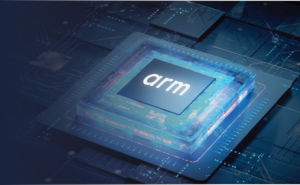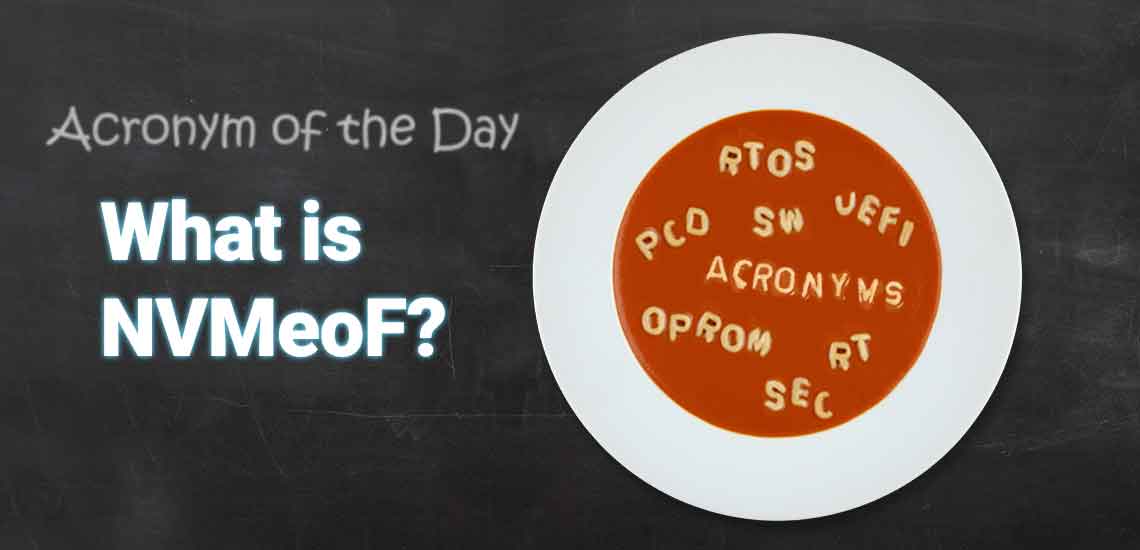In today’s post on Acronym Soup, we step over to the manageability side of things and ask the question: what is NVMeoF?
NVMeoF is an acronym for “NVM Express® (or NVMe™) over Fabrics” … which of course, begs the question: what is NVMe? Naturally, to make sense of NVMeoF, first we should understand better what NVMe / NVM Express is.
NVMe stands for Non-Volatile Memory Express and came into being as the standard way to access flash cards or drives, connected to a server’s fast memory bus by the slower PCIe (Peripheral Component Interconnect Express) bus. Using the PCIe bus is vastly faster than connecting such drives by the SATA or SAS protocols.
According to the NVM Express website, whose organization is made up of key players in the computing, switch, interconnect and storage fields, NVMe can be defined in this way:
NVM Express® is an open collection of standards and information to fully expose the benefits of non-volatile memory in all types of computing environments from mobile to data center. NVMe™ is designed from the ground up to deliver high bandwidth and low latency storage access for current and future NVMe technologies.
Getting a little more technical, NVMe is described as:
…a scalable host controller interface designed to address the needs of Enterprise, Data Center and Client systems that utilize PCI Express® (PCIe®) based solid state drives. The interface provides an optimized command issue and completion path. It includes support for parallel operation by supporting up to 64K commands within a single I/O queue to the device. Additionally, support has been added for many Enterprise capabilities like end-to-end data protection (compatible with T10 DIF and DIX standards), enhanced error reporting, and virtualization.
Now that we have a better idea about the NVMe interface, let’s take a closer look at NVMe over Fabrics, or NVMeoF. In short, NVMe over Fabrics is an extension to NVM Express that goes beyond PCIe, allowing the NVM Express command set to be used over various additional networked interfaces. This brings the benefits of the efficient NVMe storage into even more data centers and enterprises by allowing the same protocol to extend over a wider range heterogeneous devices and interfaces.
Once again, if we go direct to the source at NVME Express we find the following description:
NVMe fabric technology is a form of block-access storage networking that gets rid of network latency delays, magically making external flash arrays as fast as internal, directly-attached, NVMe flash drives. How does it manage this trick?
An NVMeoF deployment involves an all-flash array, adapters and cabling to link it to a bunch of servers, each with their own adapters and NVMeoF drivers. The applications running in these servers require 20-30 microsecond access to data and there is vastly more data than can fit affordably in these servers’ collective DRAM… These characteristics could suit large scale OLTP, low-latency database access for web commerce, real-time data warehousing and analytics and any other application where multiple servers are in an I/O-bound state waiting for data from stores that are too big (and costly) to put in memory but which could be put in flash if the value to the enterprise is high enough.
Naturally, the NVM Express organization is deeply involved in NVMeoF standardization, as well as several key industry players and other related standards groups. According to respected tech industry website The Register, the SNIA (Storage Networking Industry organization) is also involved with the standardization of NVMe over a range Fabric types, initially RDMA (RoCE, iWARP, InfiniBand) and Fibre Channel, and also FCoE.
Recently, several switch, interconnect, storage providers including Microsemi, AMI, Brocade and QLogic have presented NVMeoF designs and proof of concepts that show great promise in boosting storage efficiency, thanks to the reduced latency that NVMe provides.
AMI has developed a unique software solution called MegaRAC FP-X Fabric Management Software to leverage the benefits of the NVMeoF interface and combine them with the traditional baseboard management controller (BMC) capabilities that MegaRAC products are known for. FP-X is founded on AMI’s widely-used MegaRAC SP-X firmware and a secure embedded web server and UI for remote access to fabric management tasks as one of its many features. More information about MegaRAC FP-X is available on the product webpage on our site here: ami.com/fabric
Thanks for reading today’s Tech Blog, we hope you found this bit of Acronym Soup refreshing and enjoyable! Feel free to drop us a line via social media or our Contact Us form and let us know – and what you might like to see in future posts!
NVM Express® and NVMe™ are registered trademarks and trademarks, respectively, of NVM Express, Inc.PCI Express® and PCIe® are registered trademarks of the PCI SIG.






